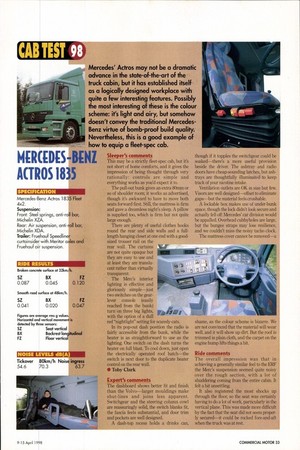mER(EDEs ACTROS 1835 Mercedes' Actros may not be a dramatic
Page 35

If you've noticed an error in this article please click here to report it so we can fix it.
advance in the state-of-the-art of the truck cabin, but it has established itself as a logically designed workplace with quite a few interesting features. Possibly the most interesting of these is the colour scheme: it's light and airy, but somehow doesn't convey the traditional MercedesBenz virtue of bomb-proof build quality. Nevertheless, this is a good example of how to equip a fleet-spec cab.
Sleeper's comments This may be a strictly fleet-spec cab, but it's not short of home comforts, and it gives the impression of being thought through very rationally: controls are simple and everything works as you'd expect it to.
The pull-out bunk gives an extra 80mm or so of shoulder room; it works as advertised, though it's awkward to have to move both seats forward first. Still, the mattress is firm and gave a dreamless night's sleep. A pillow is supplied too, which is firm but not quite large enough.
The Merc's interior lighting is effective and gloriously simple—just two switches on the gearlever console (easily reached from the bunk) turn on three big lights, with the option of a dull red "nightlight" setting for scaredy-cats.
In its pop-out dash position the radio is fairly accessible from the bunk, while the heater is as straightforward to use as the lighting. One switch on the dash turns the heater on full blast. To cool down, just open the electrically operated roof hatch the switch is next door to the duplicate heater control on the rear wall.
• Toby Clark Expert's comments The dashboard shows better fit and finish than the Volvo—larger mouldings make shut-lines and joins less apparent. Switchgear and the steering column cowl are reassuringly solid, the switch blanks fit, the fascia feels substantial, and door trim and pockets are well designed.
A dash-top recess holds a drinks can, though if it topples the switchgear could be soaked—there's a more useful provision beside the driver. The ashtray and radio doors have cheap-sounding latches, but ashtrays are thoughtfully illuminated to keep track of your nicotine intake.
Ventilation outlets are OK in size but few. Visors are well designed—offset to eliminate gaps—but the material feels crushable.
A lockable box makes use of under-bunk space, though the lock didn't look secure and actually fell off: Mercedes' car division would be appalled. Overhead cubbyholes are large, but the bungee straps may lose resilience, and we couldn't miss the noisy tacho clock.
The mattress cover cannot be removed—a shame, as the colour scheme is bizarre. We are not convinced that the material will wear well, and it will show up dirt. But the roof is trimmed in plain cloth, and the carpet on the engine hump lifts things a bit.
Ride comments The overall impression was that in achieving a generally similar feel to the ERF the Merc's suspension seemed quite noisy over the rough section, with a lot of shuddering coming from the entire cabin. It felt a bit unsettling.
It also registered the most shocks up through the floor, so the seat was certainly having to do a lot of work, particularly in the vertical plane. This was made more difficult by the fact that the seat did not seem proper ly secured—it could be rocked fore-and-a when the truck was at rest.










































































































